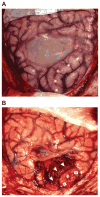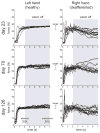The effects of acute cortical somatosensory deafferentation on grip force control
- PMID: 26587914
- PMCID: PMC4724548
- DOI: 10.1016/j.cortex.2015.10.007
The effects of acute cortical somatosensory deafferentation on grip force control
Abstract
Grip force control involves mechanisms to adjust to unpredictable and predictable changes in loads during manual manipulation. Somatosensory feedback is critical not just to reactive, feedback control but also to updating the internal representations needed for proactive, feedforward control. The role of primary somatosensory cortex (S1) in these control strategies is not well established. Here we investigated grip force control in a rare case of acute central deafferentation following resection of S1. The subject had complete loss of somatosensation in the right arm without any deficit in muscle strength or reflexes. In the first task, the subject was asked to maintain a constant grip force with and without visual feedback. The subject was able to attain the target force with visual feedback but not maintain that force for more than a few seconds after visual feedback was removed. In the second task, the subject was asked to grip and move an instrumented object. The induced acceleration-dependent loads were countered by adjustments in grip force. Both amplitude and timing of the grip force modulation were not affected by deafferentation. The dissociation of these effects demonstrates the differential contribution of S1 to the mechanisms of grip force control.
Keywords: Deafferentation; Internal model; Lesion; Motor control; Somatosensory.
Copyright © 2015 Elsevier Ltd. All rights reserved.
Figures



References
-
- Babin-Ratte S, Sirigu A, Gilles M, Wing A. Impaired anticipatory finger grip-force adjustments in a case of cerebellar degeneration. Exp Brain Res. 1999;128(1–2):81–85. - PubMed
-
- Brochier T, Boudreau MJ, Pare M, Smith AM. The effects of muscimol inactivation of small regions of motor and somatosensory cortex on independent finger movements and force control in the precision grip. Exp Brain Res. 1999;128(1–2):31–40. - PubMed
-
- Ehrsson HH, Fagergren A, Jonsson T, Westling G, Johansson RS, Forssberg H. Cortical activity in precision-versus power-grip tasks: an fMRI study. J Neurophysiol. 2000;83(1):528–536. - PubMed
-
- Fellows SJ, Ernst J, Schwarz M, Topper R, Noth J. Precision grip deficits in cerebellar disorders in man. Clin Neurophysiol. 2001;112(10):1793–1802. - PubMed
Publication types
MeSH terms
Grants and funding
LinkOut - more resources
Full Text Sources
Other Literature Sources

